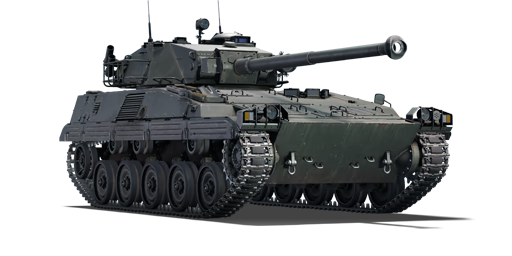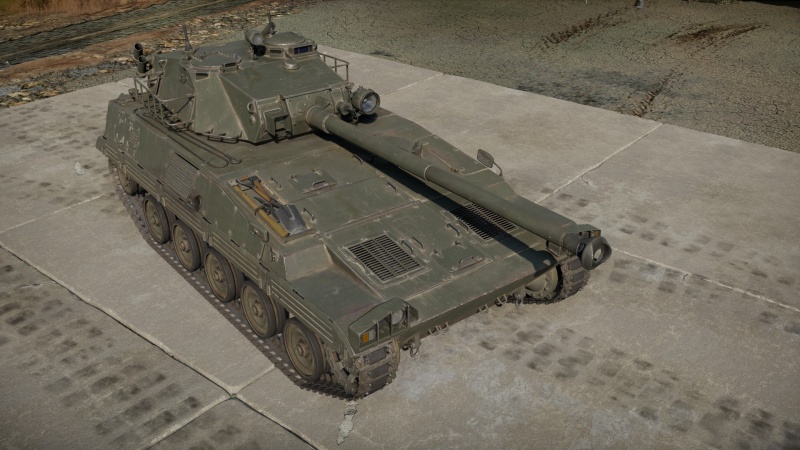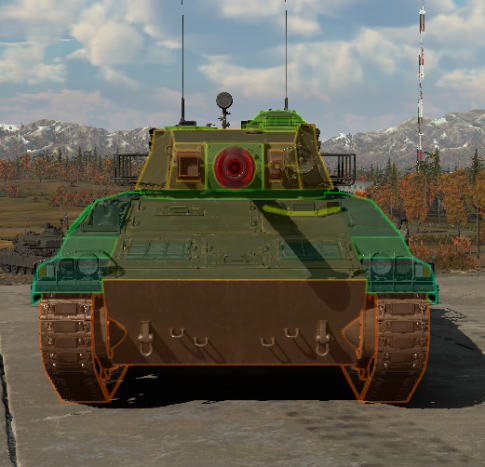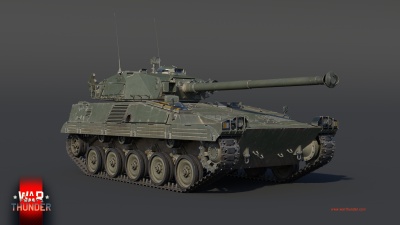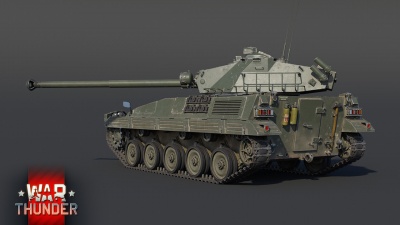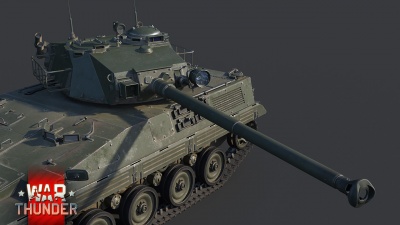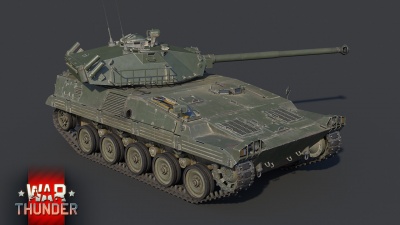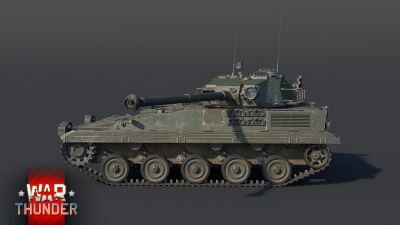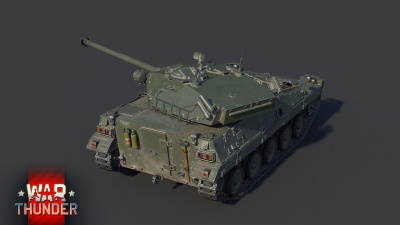Difference between revisions of "MARS 15"
(→Usage in battles: Added some stuff to the usage in battles.) (Tag: Visual edit) |
(→Mobility: Updated) |
||
| (15 intermediate revisions by 7 users not shown) | |||
| Line 6: | Line 6: | ||
== Description == | == Description == | ||
<!-- ''In the description, the first part should be about the history of the creation and combat usage of the vehicle, as well as its key features. In the second part, tell the reader about the ground vehicle in the game. Insert a screenshot of the vehicle, so that if the novice player does not remember the vehicle by name, he will immediately understand what kind of vehicle the article is talking about.'' --> | <!-- ''In the description, the first part should be about the history of the creation and combat usage of the vehicle, as well as its key features. In the second part, tell the reader about the ground vehicle in the game. Insert a screenshot of the vehicle, so that if the novice player does not remember the vehicle by name, he will immediately understand what kind of vehicle the article is talking about.'' --> | ||
| − | The ''' | + | The '''MARS 15''' is a French light tank prototype that was designed and built by Creusot-Loire Industrie with the support of Renk, SAM, Valeo, and Baudouin cooperations between the 1980s and 1992. It was originally intended for export to replace the now-obsolete [[AMX-13 (Family)|AMX-13 light tanks]], one of the best-selling tank series in the world with 35 client nations between 1953 and 1985, and forty years of service and remarkable success in France and abroad due to their simplicity and versatility. The MARS 15 was originally shown at the Satory 90 exhibition and then again at Eurosatory in 1992, with an upgraded variant for the final time. However, the MARS 15 failed to meet expectations and was never mass-produced on a large scale, despite having several advantages, such as modularity, and failed to gain international popularity, much like the [[AMX-40|AMX-40 main battle tank]]. As a result, the project was eventually cancelled. |
| + | |||
| + | Introduced in [[Update "Ixwa Strike"]], the MARS 15 is an excellent scouting vehicle. Given its high mobility and low profile, it is easy to flank and scout the opponent for your allies. Close-quarters engagements are not encouraged, as the inadequate armour does not provide sufficient protection against other vehicles. An effective way to play MARS 15 is to focus on flanking the adversary and engaging the enemy from flanking positions on the sides. If players find themselves in a dangerous situation, the MARS 15 carries four smoke grenades that can provide an effective means of evading danger and repositioning. | ||
== General info == | == General info == | ||
| Line 12: | Line 14: | ||
{{Specs-Tank-Armour}} | {{Specs-Tank-Armour}} | ||
<!-- ''Describe armour protection. Note the most well protected and key weak areas. Appreciate the layout of modules as well as the number and location of crew members. Is the level of armour protection sufficient, is the placement of modules helpful for survival in combat? If necessary use a visual template to indicate the most secure and weak zones of the armour.'' --> | <!-- ''Describe armour protection. Note the most well protected and key weak areas. Appreciate the layout of modules as well as the number and location of crew members. Is the level of armour protection sufficient, is the placement of modules helpful for survival in combat? If necessary use a visual template to indicate the most secure and weak zones of the armour.'' --> | ||
| − | At first sight, the MARS 15 might look like it lacks any real armour, | + | [[File:MARS15 heatmap.png|thumb|485x485px|MARS 15 Armour Heatmap]] |
| + | At first sight, the MARS 15 might look like it lacks any real armour, with its pitiful 11 mm thick top glacis armour. However, these 11 mm are quite adequate at stopping rounds from autocannons and small-calibre rounds, thanks to the glacis' steep angle of 80°. This is overall boosted by the internal plate that separates the crew compartment and the front of the tank. As an added protection, the transmission, engine block and the radiator are placed in front of the tank, which help with stopping HEAT rounds. | ||
| + | |||
| + | However, all of this added protection won't help the tank survive an APFSDS round as most of the time it will have no problems penetrating the front of the tank and due to the crew placement and because only 3 crew members are inside of the vehicle, most APFSDS rounds will destroy the tank with a single hit. A major weak spot is the left part of the driver's optics. A shot trough these optics will result in the incapacitation of the driver and most of the time either the gunner or the loader. If the user survives a shot like this, another problem would be the 5-round rack back left part of the tank, however the user can bypass this issue by loading only 14 rounds. This way, only the ammo rack on the right side of the tank will have rounds stored inside, boosting the chance of survival slightly. | ||
| − | + | As mentioned above, holding more than 14 rounds might be a problem for some. But due to the overall low survivability of the tank itself, taking 19 rounds might be an optimal way to play. Taking more than 19 rounds will result in the rounds being placed on the racks on both sides of the tank, which might make the user very susceptible to side shots, but the rounds will also start storing inside of the bottom and the back of the turret (not counting the first stage ammo rack which is on the left side of the turret). | |
| − | + | While you might stop a HEATFS round that has been flung your way, or you might shrug some 20 mm autocannon rounds, aircraft will be the bane of your existence. Due to the thin roof, pretty much any aircraft can quickly wipe you out by just using its guns. Sadly, the only reliable protection is to try to find some cover, either indoors or hide behind a sufficiently high object. If none of these options are available, the only option left is to pray that your team has an AA or a friendly jet roaming around that just might save you. | |
| − | '''Armour type:''' | + | '''Armour type:''' |
| − | |||
| − | |||
* Rolled homogeneous armour (Hull, Turret, Internal plate) | * Rolled homogeneous armour (Hull, Turret, Internal plate) | ||
| Line 28: | Line 31: | ||
! Armour !! Front (Slope angle) !! Sides !! Rear !! Roof | ! Armour !! Front (Slope angle) !! Sides !! Rear !! Roof | ||
|- | |- | ||
| − | | Hull || 11 mm (80°) ''Top Glacis'' | + | | Hull || 11 mm (80°) ''Top Glacis'' <br> 15 mm (40°) ''Bottom Glacis'' || 5 mm (20°) ''Top'' <br> 10 mm ''Bottom'' || 10 mm (10°) || 8-11 mm (80-90°) |
| − | 15 mm (40°) ''Bottom Glacis'' | ||
| − | | 5 mm (20°) ''Top'' <br>10 mm | ||
|- | |- | ||
| − | | Turret || 10 - 15 mm ''Turret front'' <br>10 mm ''Gun mantlet'' || 8 - 12 mm ( | + | | Turret || 10-15 mm ''Turret front'' <br> 10 mm ''Gun mantlet'' || 8-12 mm (0-30°) || 8-10 mm || 10-12 mm |
|- | |- | ||
| − | | Cupola || 10 mm ( | + | | Cupola || 10 mm (5-90°) || 10 mm (12-75°) || 10 mm (61°) || 10 mm (58-85°) |
|- | |- | ||
|} | |} | ||
| + | '''Notes:''' | ||
| − | + | * The torsion bars, suspension wheels and the tracks are 15 mm thick. | |
| − | + | * The internal plate protecting the crew compartment is 10 mm thick. | |
| − | |||
| − | * The torsion bars, suspension wheels and the tracks are 15 mm thick | ||
| − | * | ||
=== Mobility === | === Mobility === | ||
{{Specs-Tank-Mobility}} | {{Specs-Tank-Mobility}} | ||
<!-- ''Write about the mobility of the ground vehicle. Estimate the specific power and manoeuvrability, as well as the maximum speed forwards and backwards.'' --> | <!-- ''Write about the mobility of the ground vehicle. Estimate the specific power and manoeuvrability, as well as the maximum speed forwards and backwards.'' --> | ||
| − | |||
| − | {{tankMobility}} | + | {{tankMobility|abMinHp=620|rbMinHp=354}} |
| + | |||
| + | The MARS 15 is a very mobile and nimble tank, with a pretty small profile. The user should expect around 48 km/h on off-road terrain and roughly -24 km/h reverse speed. It takes roughly 13 seconds for the tank to fully do a 360° rotation with neutral steering, however if the user gets some speed before turning, it will do the 360° rotation roughly 50% faster. It is powered by a Baudouin GF12SRY diesel engine, producing 400 hp for a top speed of roughly 75 km/h. | ||
=== Modifications and economy === | === Modifications and economy === | ||
| Line 60: | Line 60: | ||
<!-- ''Give the reader information about the characteristics of the main gun. Assess its effectiveness in a battle based on the reloading speed, ballistics and the power of shells. Do not forget about the flexibility of the fire, that is how quickly the cannon can be aimed at the target, open fire on it and aim at another enemy. Add a link to the main article on the gun: <code><nowiki>{{main|Name of the weapon}}</nowiki></code>. Describe in general terms the ammunition available for the main gun. Give advice on how to use them and how to fill the ammunition storage.'' --> | <!-- ''Give the reader information about the characteristics of the main gun. Assess its effectiveness in a battle based on the reloading speed, ballistics and the power of shells. Do not forget about the flexibility of the fire, that is how quickly the cannon can be aimed at the target, open fire on it and aim at another enemy. Add a link to the main article on the gun: <code><nowiki>{{main|Name of the weapon}}</nowiki></code>. Describe in general terms the ammunition available for the main gun. Give advice on how to use them and how to fill the ammunition storage.'' --> | ||
{{main|CN90 F4 (90 mm)}} | {{main|CN90 F4 (90 mm)}} | ||
| − | |||
{| class="wikitable" style="text-align:center" width="100%" | {| class="wikitable" style="text-align:center" width="100%" | ||
| Line 71: | Line 70: | ||
|- | |- | ||
! ''Arcade'' | ! ''Arcade'' | ||
| − | | rowspan="2" | 30 || rowspan="2" | -8°/+ | + | | rowspan="2" | 30 || rowspan="2" | -8°/+15° || rowspan="2" | ±180° || rowspan="2" | N/A || 22.8 || 31.6 || 38.4 || 42.5 || 45.2 || rowspan="2" | 6.50 || rowspan="2" | 5.75 || rowspan="2" | 5.30 || rowspan="2" | 5.00 |
|- | |- | ||
! ''Realistic'' | ! ''Realistic'' | ||
| − | | | + | | 14.3 || 16.8 || 20.4 || 22.6 || 24.0 |
|- | |- | ||
|} | |} | ||
==== Ammunition ==== | ==== Ammunition ==== | ||
| − | { | + | {{:CN90 F4 (90 mm)/Ammunition|OCC 90 F2, OFUM 90 F1, OE 90 F1, OFL 90 F1}} |
| − | |||
| − | |||
| − | |||
| − | |||
| − | |||
| − | |||
| − | |||
| − | |||
| − | | OCC 90 F2 | ||
| − | |||
| − | |||
| − | |||
| − | |||
| − | |||
| − | |||
| − | |||
| − | |||
| − | |||
| − | |||
| − | |||
| − | |||
| − | |||
| − | |||
| − | |||
| − | |||
| − | |||
| − | |||
| − | |||
| − | |||
| − | |||
| − | |||
| − | |||
| − | |||
| − | |||
| − | |||
| − | |||
| − | |||
| − | |||
| − | |||
| − | |||
| − | |||
| − | |||
| − | |||
| − | |||
| − | |||
| − | |||
| − | |||
| − | |||
| − | |||
| − | |||
| − | |||
| − | |||
| − | |||
==== [[Ammo racks]] ==== | ==== [[Ammo racks]] ==== | ||
| − | + | [[File:Ammoracks_{{PAGENAME}}.jpg|right|thumb|x250px|[[Ammo racks]] of the {{PAGENAME}}]] | |
| − | <!-- '''Last updated:''' --> | + | <!-- '''Last updated: 2.5.0.23''' --> |
{| class="wikitable" style="text-align:center" | {| class="wikitable" style="text-align:center" | ||
|- | |- | ||
| Line 148: | Line 94: | ||
! Visual<br>discrepancy | ! Visual<br>discrepancy | ||
|- | |- | ||
| − | | '''30''' || | + | | '''30''' || 29 ''(+1)'' || 21 ''(+9)'' || 19 ''(+11)'' || 14 ''(+16)'' || 9 ''(+21)'' || 1 ''(+29)'' || No |
|- | |- | ||
|} | |} | ||
| + | Notes: | ||
| + | |||
| + | * Shells are modeled individually and disappear after having been shot or loaded. | ||
| + | * Rack 6 is a first stage ammo rack. It totals 8 shells and gets filled first when loading up the tank. | ||
=== Machine guns === | === Machine guns === | ||
| Line 156: | Line 106: | ||
<!-- ''Offensive and anti-aircraft machine guns not only allow you to fight some aircraft but also are effective against lightly armoured vehicles. Evaluate machine guns and give recommendations on its use.'' --> | <!-- ''Offensive and anti-aircraft machine guns not only allow you to fight some aircraft but also are effective against lightly armoured vehicles. Evaluate machine guns and give recommendations on its use.'' --> | ||
{{main|A-A-F1N (7.62 mm)}} | {{main|A-A-F1N (7.62 mm)}} | ||
| − | The A-A-F1N is largely ineffective at taking out any | + | |
| + | The A-A-F1N is largely ineffective at taking out any armoured target and its only real use comes to play against vehicles with exposed crew members. Thanks to the large fire rate, one can dispatch such tank with relative ease. It can also be used to "ping" enemy targets for your teammates or to destroy environmental objects such as fences. | ||
{| class="wikitable" style="text-align:center" width="50%" | {| class="wikitable" style="text-align:center" width="50%" | ||
| Line 164: | Line 115: | ||
! Mount !! Capacity (Belt) !! Fire rate !! Vertical !! Horizontal | ! Mount !! Capacity (Belt) !! Fire rate !! Vertical !! Horizontal | ||
|- | |- | ||
| − | | | + | | Coaxial || 2,000 (100) || 900 || N/A || N/A |
| − | | 2,000 (100) || 900 | ||
|- | |- | ||
|} | |} | ||
| Line 171: | Line 121: | ||
== Usage in battles == | == Usage in battles == | ||
<!-- ''Describe the tactics of playing in the vehicle, the features of using vehicles in the team and advice on tactics. Refrain from creating a "guide" - do not impose a single point of view but instead give the reader food for thought. Describe the most dangerous enemies and give recommendations on fighting them. If necessary, note the specifics of the game in different modes (AB, RB, SB).'' --> | <!-- ''Describe the tactics of playing in the vehicle, the features of using vehicles in the team and advice on tactics. Refrain from creating a "guide" - do not impose a single point of view but instead give the reader food for thought. Describe the most dangerous enemies and give recommendations on fighting them. If necessary, note the specifics of the game in different modes (AB, RB, SB).'' --> | ||
| − | |||
| − | |||
| − | |||
| − | |||
| − | |||
| − | |||
| − | + | The MARS 15 is effective as a scout vehicle. Because of the good mobility and low profile, it is easy to flank the enemy and scout them for your team. Engaging in brawls is not recommended as the mediocre armour does not provide adequate protection against other vehicles that the MARS will face. Focusing on flanking the enemy and/or engaging the enemy from vantage points from the sides is an adequate way of playing the MARS. If for some reason the user finds themselves in a tough spot, the MARS has 4 smoke grenades that can provide a reliable way of escaping danger and repositioning. | |
| − | The | ||
| − | + | Although the user has access to an APFSDS round, using it is rather questionable and situational. The power of it is rather average at best, but on the flipside, it provides quite a boost to the round velocity. A good tactic is to take both HEATFS and APFSDS if the user plans on sniping but also flanking. The APFSDS should be used at longer ranges where the target might be moving too fast for the HEATFS to be reliable, or in case environmental objects such as bushes are in front of the user as hitting these with HEAT rounds will most likely detonate them, giving away the user's position. | |
| − | + | If the user prefers to snipe crew members or the enemy tank's ammo racks, the APFSDS is good enough to fulfill that role, but spare HEATFS rounds should always be carried in case the user needs some extra penetration power. | |
=== Pros and cons === | === Pros and cons === | ||
| Line 191: | Line 134: | ||
* Low profile | * Low profile | ||
| − | * Good mobility | + | * Good mobility |
| − | * Access to a laser rangefinder | + | * Access to a laser rangefinder |
| + | * Access to night vision | ||
'''Cons:''' | '''Cons:''' | ||
* No gun stabilization | * No gun stabilization | ||
| − | * Very light protection | + | * Very light protection |
| − | + | * Because of the OFL 90 F1, rather weak penetration power and below average spalling, one-hit kills are unreliable | |
| − | * Because of the OFL 90 F1 rather weak penetration power and below average spalling, one hit kills are unreliable | ||
== History == | == History == | ||
| Line 208: | Line 151: | ||
Full-scale development only began in 1988 and several variants of the vehicle were developed, ranging from light tank modifications over APCs and IFVs to SPAAs and SPHs as well as a number of other variants. However, many of these planned variants never passed the drawing board stage. Of the few that did, the light tank modification stood out as it aimed to build upon the popular characteristics of the AMX-13 and expand upon them by incorporating modern technologies. | Full-scale development only began in 1988 and several variants of the vehicle were developed, ranging from light tank modifications over APCs and IFVs to SPAAs and SPHs as well as a number of other variants. However, many of these planned variants never passed the drawing board stage. Of the few that did, the light tank modification stood out as it aimed to build upon the popular characteristics of the AMX-13 and expand upon them by incorporating modern technologies. | ||
| − | This light tank modification featured a small and extremely nimble chassis while being armed with a 90 mm cannon and promising low maintenance efforts. The first and only prototype of this variant was shown off in 1990, along with the IFV modification. After its reveal, the vehicle received the designation MARS 15. | + | This light tank modification featured a small and extremely nimble chassis while being armed with a 90 mm cannon and promising low maintenance efforts. The first and only prototype of this variant was shown off in 1990, along with the IFV modification. After its reveal, the vehicle received the designation MARS 15. |
In 1991, another prototype armed with a 105 mm cannon was shown off which would also become the last of the series. In fact, the expected response from potential foreign customers never materialized as the end of the Cold War in the early 1990s diminished the demand for new tanks while simultaneously surplus MBTs were being taken out of storage and sold. As a result of this development, the MARS vehicles never left the prototype stage and were ultimately abandoned. | In 1991, another prototype armed with a 105 mm cannon was shown off which would also become the last of the series. In fact, the expected response from potential foreign customers never materialized as the end of the Cold War in the early 1990s diminished the demand for new tanks while simultaneously surplus MBTs were being taken out of storage and sold. As a result of this development, the MARS vehicles never left the prototype stage and were ultimately abandoned. | ||
| Line 214: | Line 157: | ||
== Media == | == Media == | ||
<!-- ''Excellent additions to the article would be video guides, screenshots from the game, and photos.'' --> | <!-- ''Excellent additions to the article would be video guides, screenshots from the game, and photos.'' --> | ||
| − | + | ||
| + | ;Skins | ||
| + | |||
| + | * [https://live.warthunder.com/feed/camouflages/?vehicle=fr_mars_15 Skins and camouflages for the {{PAGENAME}} from live.warthunder.com.] | ||
| + | |||
| + | ;Images | ||
| + | <gallery mode="packed" heights="150"> | ||
| + | File:Mars 15 WTWallpaper 01.jpg| | ||
| + | File:MARS Devblog 4.jpg| | ||
| + | File:MARS Devblog 3.jpg| | ||
| + | File:Mars 15 WTWallpaper 04.jpg| | ||
| + | File:MARS Devblog 2.jpg| | ||
| + | File:MARS Devblog.jpg| | ||
| + | </gallery> | ||
== See also == | == See also == | ||
| Line 220: | Line 176: | ||
* ''reference to the series of the vehicles;'' | * ''reference to the series of the vehicles;'' | ||
* ''links to approximate analogues of other nations and research trees.'' --> | * ''links to approximate analogues of other nations and research trees.'' --> | ||
| − | |||
| − | * | + | * [[Object 906]] - A similar Soviet light tank |
| − | |||
== External links == | == External links == | ||
| Line 230: | Line 184: | ||
* ''other literature.'' --> | * ''other literature.'' --> | ||
| − | * [http://www.military-today.com/tanks/mars_15.htm <nowiki>[ | + | * [[wt:en/news/7082-development-mars-15-light-cavalry-en|[Devblog] MARS 15: Light Cavalry]] |
| + | * [http://www.military-today.com/tanks/mars_15.htm <nowiki>[Military Today] MARS 15</nowiki>] | ||
{{France light tanks}} | {{France light tanks}} | ||
Latest revision as of 20:40, 21 October 2023
Contents
Description
The MARS 15 is a French light tank prototype that was designed and built by Creusot-Loire Industrie with the support of Renk, SAM, Valeo, and Baudouin cooperations between the 1980s and 1992. It was originally intended for export to replace the now-obsolete AMX-13 light tanks, one of the best-selling tank series in the world with 35 client nations between 1953 and 1985, and forty years of service and remarkable success in France and abroad due to their simplicity and versatility. The MARS 15 was originally shown at the Satory 90 exhibition and then again at Eurosatory in 1992, with an upgraded variant for the final time. However, the MARS 15 failed to meet expectations and was never mass-produced on a large scale, despite having several advantages, such as modularity, and failed to gain international popularity, much like the AMX-40 main battle tank. As a result, the project was eventually cancelled.
Introduced in Update "Ixwa Strike", the MARS 15 is an excellent scouting vehicle. Given its high mobility and low profile, it is easy to flank and scout the opponent for your allies. Close-quarters engagements are not encouraged, as the inadequate armour does not provide sufficient protection against other vehicles. An effective way to play MARS 15 is to focus on flanking the adversary and engaging the enemy from flanking positions on the sides. If players find themselves in a dangerous situation, the MARS 15 carries four smoke grenades that can provide an effective means of evading danger and repositioning.
General info
Survivability and armour
At first sight, the MARS 15 might look like it lacks any real armour, with its pitiful 11 mm thick top glacis armour. However, these 11 mm are quite adequate at stopping rounds from autocannons and small-calibre rounds, thanks to the glacis' steep angle of 80°. This is overall boosted by the internal plate that separates the crew compartment and the front of the tank. As an added protection, the transmission, engine block and the radiator are placed in front of the tank, which help with stopping HEAT rounds.
However, all of this added protection won't help the tank survive an APFSDS round as most of the time it will have no problems penetrating the front of the tank and due to the crew placement and because only 3 crew members are inside of the vehicle, most APFSDS rounds will destroy the tank with a single hit. A major weak spot is the left part of the driver's optics. A shot trough these optics will result in the incapacitation of the driver and most of the time either the gunner or the loader. If the user survives a shot like this, another problem would be the 5-round rack back left part of the tank, however the user can bypass this issue by loading only 14 rounds. This way, only the ammo rack on the right side of the tank will have rounds stored inside, boosting the chance of survival slightly.
As mentioned above, holding more than 14 rounds might be a problem for some. But due to the overall low survivability of the tank itself, taking 19 rounds might be an optimal way to play. Taking more than 19 rounds will result in the rounds being placed on the racks on both sides of the tank, which might make the user very susceptible to side shots, but the rounds will also start storing inside of the bottom and the back of the turret (not counting the first stage ammo rack which is on the left side of the turret).
While you might stop a HEATFS round that has been flung your way, or you might shrug some 20 mm autocannon rounds, aircraft will be the bane of your existence. Due to the thin roof, pretty much any aircraft can quickly wipe you out by just using its guns. Sadly, the only reliable protection is to try to find some cover, either indoors or hide behind a sufficiently high object. If none of these options are available, the only option left is to pray that your team has an AA or a friendly jet roaming around that just might save you.
Armour type:
- Rolled homogeneous armour (Hull, Turret, Internal plate)
| Armour | Front (Slope angle) | Sides | Rear | Roof |
|---|---|---|---|---|
| Hull | 11 mm (80°) Top Glacis 15 mm (40°) Bottom Glacis |
5 mm (20°) Top 10 mm Bottom |
10 mm (10°) | 8-11 mm (80-90°) |
| Turret | 10-15 mm Turret front 10 mm Gun mantlet |
8-12 mm (0-30°) | 8-10 mm | 10-12 mm |
| Cupola | 10 mm (5-90°) | 10 mm (12-75°) | 10 mm (61°) | 10 mm (58-85°) |
Notes:
- The torsion bars, suspension wheels and the tracks are 15 mm thick.
- The internal plate protecting the crew compartment is 10 mm thick.
Mobility
| Game Mode | Max Speed (km/h) | Weight (tons) | Engine power (horsepower) | Power-to-weight ratio (hp/ton) | |||
|---|---|---|---|---|---|---|---|
| Forward | Reverse | Stock | Upgraded | Stock | Upgraded | ||
| Arcade | 84 | 84 | 16 | 620 | 763 | 38.75 | 47.69 |
| Realistic | 76 | 76 | 354 | 400 | 22.13 | 25 | |
The MARS 15 is a very mobile and nimble tank, with a pretty small profile. The user should expect around 48 km/h on off-road terrain and roughly -24 km/h reverse speed. It takes roughly 13 seconds for the tank to fully do a 360° rotation with neutral steering, however if the user gets some speed before turning, it will do the 360° rotation roughly 50% faster. It is powered by a Baudouin GF12SRY diesel engine, producing 400 hp for a top speed of roughly 75 km/h.
Modifications and economy
Armaments
Main armament
| 90 mm CN90 F4 | Turret rotation speed (°/s) | Reloading rate (seconds) | |||||||||||
|---|---|---|---|---|---|---|---|---|---|---|---|---|---|
| Mode | Capacity | Vertical | Horizontal | Stabilizer | Stock | Upgraded | Full | Expert | Aced | Stock | Full | Expert | Aced |
| Arcade | 30 | -8°/+15° | ±180° | N/A | 22.8 | 31.6 | 38.4 | 42.5 | 45.2 | 6.50 | 5.75 | 5.30 | 5.00 |
| Realistic | 14.3 | 16.8 | 20.4 | 22.6 | 24.0 | ||||||||
Ammunition
| Penetration statistics | |||||||
|---|---|---|---|---|---|---|---|
| Ammunition | Type of warhead |
Penetration @ 0° Angle of Attack (mm) | |||||
| 10 m | 100 m | 500 m | 1,000 m | 1,500 m | 2,000 m | ||
| OCC 90 F2 | HEATFS | 350 | 350 | 350 | 350 | 350 | 350 |
| OE 90 F1 | HE | 18 | 17 | 16 | 15 | 13 | 13 |
| OFL 90 F1 | APFSDS | 271 | 267 | 253 | 235 | 218 | 201 |
| Shell details | ||||||||||||
|---|---|---|---|---|---|---|---|---|---|---|---|---|
| Ammunition | Type of warhead |
Velocity (m/s) |
Projectile mass (kg) |
Fuse delay (m) |
Fuse sensitivity (mm) |
Explosive mass (TNT equivalent) (g) |
Ricochet | |||||
| 0% | 50% | 100% | ||||||||||
| OCC 90 F2 | HEATFS | 950 | 8.95 | 0.05 | 0.1 | 877.7 | 65° | 72° | 77° | |||
| OE 90 F1 | HE | 750 | 10.45 | 0.2 | 0.1 | 945 | 79° | 80° | 81° | |||
| OFL 90 F1 | APFSDS | 1,275 | 2.33 | - | - | - | 78° | 80° | 81° | |||
| Smoke shell characteristics | ||||||
|---|---|---|---|---|---|---|
| Ammunition | Velocity (m/s) |
Projectile mass (kg) |
Screen radius (m) |
Screen deploy time (s) |
Screen hold time (s) |
Explosive mass (TNT equivalent) (g) |
| OFUM 90 F1 | 750 | 10.2 | 9 | 5 | 20 | 50 |
Ammo racks
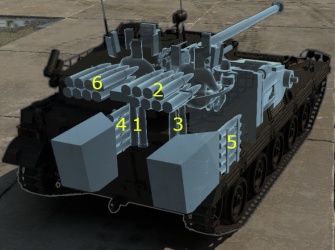
| Full ammo |
1st rack empty |
2nd rack empty |
3rd rack empty |
4th rack empty |
5th rack empty |
6th rack empty |
Visual discrepancy |
|---|---|---|---|---|---|---|---|
| 30 | 29 (+1) | 21 (+9) | 19 (+11) | 14 (+16) | 9 (+21) | 1 (+29) | No |
Notes:
- Shells are modeled individually and disappear after having been shot or loaded.
- Rack 6 is a first stage ammo rack. It totals 8 shells and gets filled first when loading up the tank.
Machine guns
The A-A-F1N is largely ineffective at taking out any armoured target and its only real use comes to play against vehicles with exposed crew members. Thanks to the large fire rate, one can dispatch such tank with relative ease. It can also be used to "ping" enemy targets for your teammates or to destroy environmental objects such as fences.
| 7.62 mm A-A-F1N | ||||
|---|---|---|---|---|
| Mount | Capacity (Belt) | Fire rate | Vertical | Horizontal |
| Coaxial | 2,000 (100) | 900 | N/A | N/A |
Usage in battles
The MARS 15 is effective as a scout vehicle. Because of the good mobility and low profile, it is easy to flank the enemy and scout them for your team. Engaging in brawls is not recommended as the mediocre armour does not provide adequate protection against other vehicles that the MARS will face. Focusing on flanking the enemy and/or engaging the enemy from vantage points from the sides is an adequate way of playing the MARS. If for some reason the user finds themselves in a tough spot, the MARS has 4 smoke grenades that can provide a reliable way of escaping danger and repositioning.
Although the user has access to an APFSDS round, using it is rather questionable and situational. The power of it is rather average at best, but on the flipside, it provides quite a boost to the round velocity. A good tactic is to take both HEATFS and APFSDS if the user plans on sniping but also flanking. The APFSDS should be used at longer ranges where the target might be moving too fast for the HEATFS to be reliable, or in case environmental objects such as bushes are in front of the user as hitting these with HEAT rounds will most likely detonate them, giving away the user's position.
If the user prefers to snipe crew members or the enemy tank's ammo racks, the APFSDS is good enough to fulfill that role, but spare HEATFS rounds should always be carried in case the user needs some extra penetration power.
Pros and cons
Pros:
- Low profile
- Good mobility
- Access to a laser rangefinder
- Access to night vision
Cons:
- No gun stabilization
- Very light protection
- Because of the OFL 90 F1, rather weak penetration power and below average spalling, one-hit kills are unreliable
History
Devblog
In the early 1980s, the French Creusot-Loire Industrie company began work on developing a new family of tracked combat vehicles which share a common chassis. Initiating work under a private venture, Creusot-Loire Industrie aimed to produce the vehicles for customers on the export market who already used the widely used AMX-13 light tank.
Full-scale development only began in 1988 and several variants of the vehicle were developed, ranging from light tank modifications over APCs and IFVs to SPAAs and SPHs as well as a number of other variants. However, many of these planned variants never passed the drawing board stage. Of the few that did, the light tank modification stood out as it aimed to build upon the popular characteristics of the AMX-13 and expand upon them by incorporating modern technologies.
This light tank modification featured a small and extremely nimble chassis while being armed with a 90 mm cannon and promising low maintenance efforts. The first and only prototype of this variant was shown off in 1990, along with the IFV modification. After its reveal, the vehicle received the designation MARS 15.
In 1991, another prototype armed with a 105 mm cannon was shown off which would also become the last of the series. In fact, the expected response from potential foreign customers never materialized as the end of the Cold War in the early 1990s diminished the demand for new tanks while simultaneously surplus MBTs were being taken out of storage and sold. As a result of this development, the MARS vehicles never left the prototype stage and were ultimately abandoned.
Media
- Skins
- Images
See also
- Object 906 - A similar Soviet light tank
External links
| France light tanks | |
|---|---|
| AMC.34/35 | AMC.34 YR · AMC.35 (ACG.1) |
| H.35/39 | H.35 · H.39 · H.39 "Cambronne" |
| AMX-13 | AMX-13 (FL11) · AMX-13-M24 · AMX-13 · AMX-13 (SS.11) · AMX-13-90 · AMX-13 (HOT) |
| Wheeled | AML-90 · AMX-10RC · Vextra 105 |
| AMD.35 | AMD.35 · AMD.35 (SA35) |
| E.B.R. | E.B.R. (1951) · E.B.R. (1954) · E.B.R. (1963) |
| Other | FCM.36 · R.35 (SA38) · Char 25t · MARS 15 · VBCI-2 (MCT30) |
| Austria | SK-105A2 |
| Great Britain | ▄Crusader Mk.II |
| Netherlands | CV 9035NL |
| USA | LVT-4/40 · ▄M3A3 Stuart |


